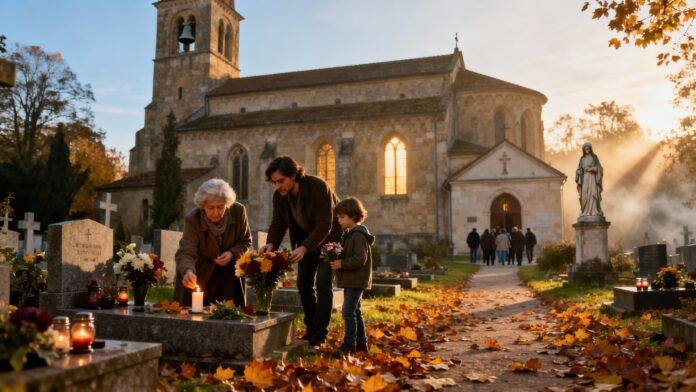Every November 1st, as autumn leaves gently carpet the paths and the air grows milder, millions of people turn towards the light of a unique feast: All Saints' Day. It is a day when the Church honors all the saints, known and unknown, to remind us that holiness is not the domain of a few isolated heroes, but the calling of each and every one of us. All Saints' Day is often confused with the following day, All Souls' Day, but it carries within it a particular joy: the joy of life in God, stronger than death.
To understand the profound meaning of this celebration, we must go back to its origins, grasp its evolution through history, and rediscover how it can still speak to our hearts today, in a world often searching for meaning.
When the martyrs paved the way
Originally, All Saints' Day was not found in the Bible. Its existence does not derive from an event recounted in the Gospels, like Christmas or Easter. It arose from the gratitude of the early Christian communities towards those who had borne witness to Christ at the cost of their lives.
In the fourth century, after the persecutions, Eastern Christians began to commemorate all the martyrs together in a single celebration. The local churches, overwhelmed by the number of witnesses to the faith, chose to unite their memory. A common liturgy, celebrated in the spring, was dedicated to them. In Rome, a similar feast appeared a century later, initially in May, to honor the martyrs who had shed their blood in the name of their faith.
But the feast took a decisive turn when Pope Gregory III, in the 8th century, decided to dedicate a chapel within St. Peter's Basilica to "all the saints." He fixed this celebration on November 1st. Then, in the following century, Pope Gregory IV extended the feast to the entire Church. The first day of November then became this universal moment of recognition and light for all the sanctified, whether canonized or unknown.

All the saints: known, unknown, and close to us
This is one of the most beautiful and profound features of All Saints' Day: its universal dimension. Far from being limited to the commemoration of the great names of the faith – Francis of Assisi, Thérèse of Lisieux, Joan of Arc or Benedict of Nursia – it encompasses a multitude that is a priori invisible: women, men, children, monks, artisans, mothers, workers, who, in the secrecy of everyday life, lived according to the Gospel.
Holiness, in this perspective, is not an unattainable perfection. It is a path of faithfulness. And All Saints' Day allows us to recognize this immense multitude, as described in the Book of Revelation: “a multitude that no one could count, from every nation, tribe, people and language.” It is a people of love, a people of light, where everyone finds their place.
Even today, each of us knows a “saint of everyday life”: a grandmother who prayed in silence, a friend with a huge heart, a doctor dedicated to serving others, a patient educator. All those who have believed, hoped, loved, and allowed God to work in their hearts enter, in a certain way, into this celebration.
A joyous celebration in a world in mourning
It is striking to note that All Saints' Day immediately precedes All Souls' Day (November 2nd). Many people confuse the two, even though they complement each other without being identical. All Saints' Day is not a celebration of death, but of eternal life. It does not invite us to lament, but to contemplate the beauty of a transfigured humanity.
When families visit the cemetery during All Saints' Day weekend, it's not simply an act of mourning, but an act of hope. Lighting a candle on a loved one's grave is to proclaim that light is stronger than darkness. It's to tell death that it doesn't have the last word.
In a world often beset by doubts about the meaning of life, All Saints' Day reminds us that happiness and fulfillment exist, that they have a face, and that they are called communion with God. It is not a distant ideal, but a promise already begun here on earth, through love lived day after day.

The Beatitudes: the heart of the message
The Gospel reading for All Saints' Day is always that of the Beatitudes. They are, so to speak, the charter of holiness. In them, Jesus proclaims blessed the poor, the meek, the peacemakers, the pure in heart, and the persecuted. This is a complete reversal of our usual criteria for success. The saint, according to Christ, is not the one who shines, but the one who loves.
Through these words, the Church reminds us each year that holiness is accessible to all. It requires neither glory nor riches, but an open heart, a life given. This is why All Saints' Day is a fundamentally joyous feast. It celebrates lives fully lived in love, and invites us to follow this path, each according to our own vocation.
A celebration to rediscover in modern life
In contemporary culture, All Saints' Day often suffers from a double misunderstanding. On the one hand, it is confused with Halloween – its secular and pagan equivalent which precedes it by a few hours. On the other hand, it seems outdated, disconnected from the frenetic pace of modern societies.
And yet, in a world saturated with images of superficial success, All Saints' Day offers a radical counter-proposal: true happiness lies not in what we possess, but in what we give. It speaks to all those who seek coherence between their values and their way of life. It reminds us that holiness, far from being exclusive, is within the reach of each and every one of us.
All Saints' Day could be described as the feast of active hope. It urges us to act, to serve, to love with greater sincerity. It is an invitation to look around us and to recognize, in the quiet kindness of others, the presence of God at work.

Between memory and mission
Celebrating the saints is also about remembering the many paths to holiness. Each era has its figures: desert monks, missionaries, mystics, educators, martyrs, and committed laypeople. All these lives trace the same path of light. But All Saints' Day is not limited to remembrance: it opens up a future.
Saints are not relics, but companions on our journey. Their example stimulates, challenges, and inspires. Christians are called to extend their mission into today's world—where justice, peace, and solidarity are sorely lacking. To be a saint today often means simply showing care, mercy, and truth in a world that lacks them.
Holiness is not outside of time: it is lived in the office, in families, at school, on social networks, where daily choices build or destroy humanity.
A universal echo
Even beyond Christianity, All Saints' Day has a spiritual significance that touches every human being. Honoring those who lived with integrity, celebrating lives dedicated to justice or compassion, keeping alive the memory of the departed—all of this has a universal quality. The Church gives voice to a profoundly human intuition: that life should not end in oblivion, that goodness should leave a lasting mark.
The message of All Saints' Day transcends religious boundaries. It touches the heart of anyone who believes that love is never lost, that it remains, transformed, alive.
A pedagogy of light
All Saints' Day is also a spiritual lesson. It teaches us to see differently, to read life with the eyes of faith. Each saint is like a prism of light through which God's tenderness is revealed in different ways. Some shine through prayer, others through service, still others through forgiveness or poverty.
Remembering them is learning to love in truth. The saints teach us practical compassion, attentiveness to others, and humility. They don't erase our weaknesses, but they show us how to overcome them with hope.
And when we celebrate All Saints' Day, we also say that good is never defeated. That even in the darkness of the world, there are seeds of light that nothing can extinguish.

Conclusion: a celebration for today
All Saints' Day, in essence, is a surprisingly modern holiday. It offers an answer to the fear of emptiness and the disillusionment of our time. It proclaims that human history is not destined for nothingness, but rather oriented towards fulfillment. It invites us to remember in order to better hope, to contemplate in order to better act.
In the grayness of November, she brings a peaceful clarity. In the tumult of the world, she breathes confidence. And in the fragility of our lives, she whispers that every gesture of love, however small, participates in this great brotherhood of saints.
All Saints' Day is the feast of a transfigured world. On this day, the Church—and indeed, all of humanity—celebrates the victory of life over death, of good over evil, of love over fear. It reminds us that holiness is not a privilege: it is a promise, within everyone's reach.



